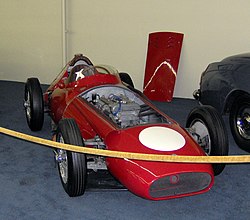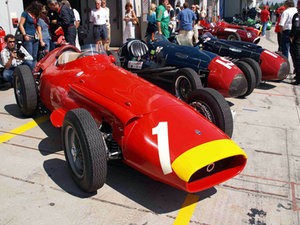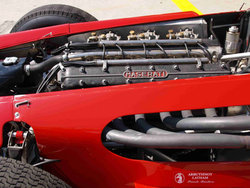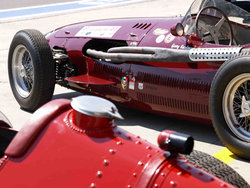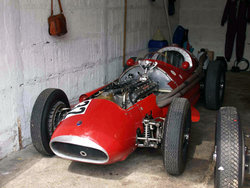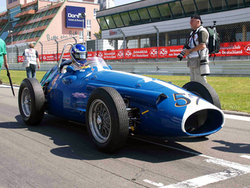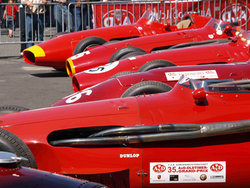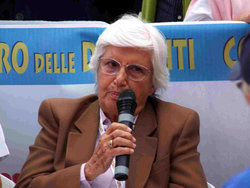Difference between revisions of "Maserati 250F"
m |
m |
||
| Line 97: | Line 97: | ||
== [http://velocetoday.com '''VeloceToday.com'''] == | == [http://velocetoday.com '''VeloceToday.com'''] == | ||
| − | '''Maserati 250F: A Winner Remembered''' | + | '''Maserati 250F: A Winner Remembered'''<br> |
| − | ''' | + | '''Story and photography by Alessandro Gerelli''' |
| − | Story and photography by Alessandro Gerelli''' | ||
[[Image:01maser.jpg|thumb|300px|center|'''Fangio’s works lightweight 250F, the winner of the 1957 Grand Prix of Germany.''']] | [[Image:01maser.jpg|thumb|300px|center|'''Fangio’s works lightweight 250F, the winner of the 1957 Grand Prix of Germany.''']] | ||
Revision as of 00:28, 30 December 2007
The Maserati 250F (first raced January 1954 - last raced November 1960) was a racing car made by Maserati of Italy, used in '2.5 litre' Formula One racing (thus, the '250' and 'F'). 26 examples were made in total. It was introduced for the 1954 Formula One season and remained in use by customer teams until 1960.
Mechanical details
It mainly used the Maserati A6 SSG straight-six 2.5-litre engine (220 bhp @ 7400 rpm), ribbed 13.4" drum brakes, wishbone independent front suspension and a De Dion tube axle. It was built by Gioacchino Colombo, Vittorio Bellentani and Alberto Massimino; the tubular work was by Valerio Colotti, then working for Maserati.
A streamlined version with bodywork which partially enclosed the wheels (similar to the 1954 Mercedes-Benz W196 "Typ Monza") was used in the 1956 French Grand Prix.
Racing history
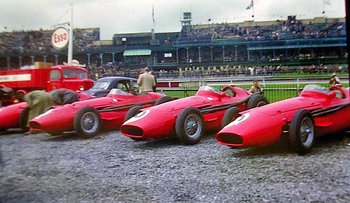
The 250F first raced in the 1954 Argentine Grand Prix where Juan Manuel Fangio won the first of his two victories before he and Stirling Moss left for the new Mercedes-Benz team. Fangio won the 1954 Drivers' World Championship, with points gained with both Maserati and Mercedes-Benz.
Although Bellentoni and Massimino left for Ferrari, 1955 saw a setup with 5-speed gearbox as well as SU fuel injection (240 bhp) and Dunlop disc brakes. Jean Behra ran this in a five-member works team which included Luigi Musso.
In 1956 Stirling Moss won at the Italian Grand Prix and the Monaco Grand Prix in his private car.
In 1956 three 250F T2 cars first appeared for the works drivers. Developed by Giulio Alfieri using lighter steel tubes they sported a slimmer, stiffer body and sometimes the new 315 bhp V12 engine, although it offered little or no real advantage over the older straight 6. It was eventually reused in the unsuccessful 1966 F1 Cooper Maserati.
In 1957 Juan Manuel Fangio drove to four more championship victories, including his legendary final win at German Grand Prix at the Nürburgring (Aug. 4, 1957), and his final race at the French Grand Prix.
The Constructors' World Championship was introduced in 1959, by which time the 250F was generally outclassed. However, the car remained a favourite with the privateers, including Maria Teresa de Filippis and was used until 1960.
In total, the 250F competed in 46 Formula One championship races with 277 entries, leading to eight wins.
Recent Media
Jeremy Clarkson had the opportunity of driving a mint condition Maserati 250F on BBC's Top Gear in 2005. He commented that the tyres were more at home on a Raleigh Chopper, and whilst travelling at great speed in the vehicle, with his face visibly contorted from the effect of wind resistance, commented "I've got no seatbelts, no roll bar, and I don't care! Michael Schumacher is dead!". He went on to lose control of the vehicle, nervously commenting "Oh no, I'm spinning in a million pounds. I've just spun a car worth a million pounds. Oh dear..."
VeloceToday.com
Maserati 250F: A Winner Remembered
Story and photography by Alessandro Gerelli
After two years of two liter unblown (F2) Grand Prix cars, dominated by the Ferrari 500 of Ascari, the FIA announced that new rules for formula one cars would be applied at the beginning of 1954: a maximum capacity of 2.5 liters for the engines without compressor and only 750 cc if supercharged. Unlike today’s complex cars and rules, there were few other requirements for the new formula.
During the 1952-53, Maserati had made use of the the A6GCM, a good car but one which was overshadowed by the speed and handling of the Ferraris. By the end of the 1953 season, however, it was well developed and Fangio won the Italian Grand Prix, the last race of the Formula 2/Formula 1 years. It proved to be a good basis on which to built a car for the new formula.
At Maserati, engineers Giaocchino Colombo, Alberto Massimino and Bellentani designed a new engine, derived from the two liters of the A6GCM. Retaining the straight 6 cylinder, the bore was increased from 76.2mm to 84mm and the stroke remained the same at 72mm, for a total displacement of 2493cc. The pistons and liners were inserted into a aluminum block and crankcase. The 12 valve head had two overhead camshafts, two magnetos, three dual-throat 42mm Weber carburetors and a six branch exhaust system. Notably, the engine was put together without gaskets, using only joint compound. The engine developed around 220 reliable horses in early 1954. The four speed gearbox was combined with the final drive and ZF limited slip, all located by a De Dion rear axle, new to the 250F.
Responsible for the chassis, transmission and braking system was Valerio Colotti. Colotti would help create the 250F in its very last guise, as the Tec- Mec in 1960, and also become famous for his gearboxes. The work as a team was not easy, but the final result was very good and satisfactory for the test driver Guerino Bertocchi, in his first drive with the car on December 26th 1953. It was claimed that 174 mph was reached at the Modena Aerodrome. Amazingly, Bertocchi had acted as riding mechanic for Alfieri Maserati some 28 years before in the 1926 Targa Florio.
[[Image:04maser.jpg|thumb|250px|right|Maserati 250F chassis 2526.'''
The name of the car was initially 6C2500 (which was too much like the earlier Alfa Romeo model designation) or 250/F1, and then more simply 250F where 250 was a contraction of 2500, the capacity of the engine in cubic centimeters.
From 1954 to 1958, thirty three 250F were produced with chassis and engine numbered from 2501 to 2534. The exception of the 2517, probably because 17 is thought to be an unlucky number in Italy. The 2513 should be only a chassis (for Tony Vandervell), and of course some chassis have been renumbered after crashes or significant changes. Denis Jenkinson also lists five “interim” A6GCM/250Fs which were numbered 2501 to 2504 and 2510, which spoils an otherwise very elegant chassis number history.
In 1957 the development of the engine was at its limit and a new engine was designed. Surprisingly, it was a flat (180 degree) 12, in order to have a very low profile. However, it was found that a 60 degrees V12 could better fit into the existing chassis of the 250F.
The chassis had to be improved for the season 1957. Six smaller and lighter chassis with a lower and more aerodynamic body were produced (the so called “lightweight”) and used both with the six and twelve cylinder engine.
Financial problems at the end of 1957, notwithstanding the World Championship gained by Fangio, caused the slow down of the development of a new chassis and soon all racing activities at Modena ceased as Maserati was forced to withdraw from racing.
Factory and privateers campaigned the 250F from 1954 till 1957 and then again in minor events until 1960. The 250F won 55 victories and one World Championshipship with Juan Manuel Fangio in 1957.
Other famous drivers of the 250F have been Moss, Musso, Prince Bira, Ascari, Villoresi, Mantovani, Marimon, Schell, Salvadori, Hawthorn, Taruffi, Brabham, Bonnier and many others, including Maria Teresa De Filippis, the first woman to drive a Formula 1 car.
The increase of vintage racing events all over the world encouraged the building of replicas: the most important ones are those of Cameron Millar, identified by CM instead of the chassis number. They are very hard to tell from the originals and are widely accepted in historical events.
A Few 250F are also displayed in museums in New Zealand, Mulhouse in France, Biscaretti in Turin, the Donington collection in UK and the Fangio museum in Argentina.
This year at the Nurburgring Oldtimer Grand-Prix, there was a celebration of 50 years since Fangio’s great victory with the Maserati 250F. A total number of 11 250Fs were present: eight produced by Maserati and three Cameron Millar replicas.
A special prize was given to Max Werner, winner of the special race driving the last car produced by Maserati (2534), a “piccolo” version with the six cylinders engine.
External links
| Maserati | |
|---|---|
| 1950-1969 | A6 | 3500 | 5000 GT | Mistral | Quattroporte I | Sebring | Mexico | Ghibli I |
| 1970-1979 | Khamsin | Bora | Indy | Merak | Quattroporte II | Quattroporte III | Kyalami |
| 1980-1999 | Biturbo | Spyder I | Quattroporte III Royale | Shamal | 220 | 228 | 420 | 430 |Karif | Barchetta | Ghibli II | Quattroporte IV | 3200 GT |
| 2000-present | Coupé-Cabrio | Coupe | Spyder II | Gran Sport | Quattroporte V | MC12 | Gran Turismo |
| Racing Vehicles | 26M · 8C · V8RI · 8CM · 8CLT · 8CTF · 8CL · 6CM · 4CL/4CLT · A6GCM · 150S · Tipo 63 · Tipo 65 · 250F · 200S · 250S · 300S · 350S · 450S · Tipo 61 "Birdcage" · Tipo 151 · Tipo 154 · MC12 GT1 · Trofeo |
| Concept Cars | Boomerang · Birdcage 75th |
| Fiat Group brands | Abarth | Alfa Romeo | Autobianchi | Ferrari | Fiat | Lancia | Innocenti | Maserati |

